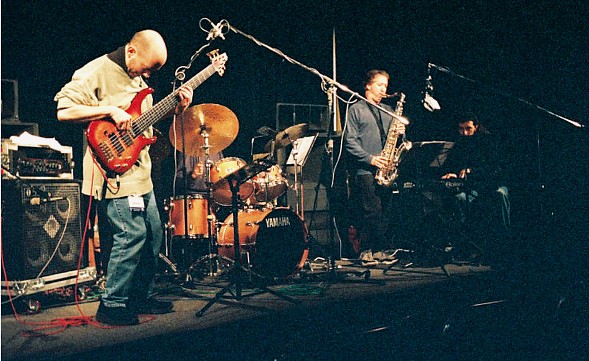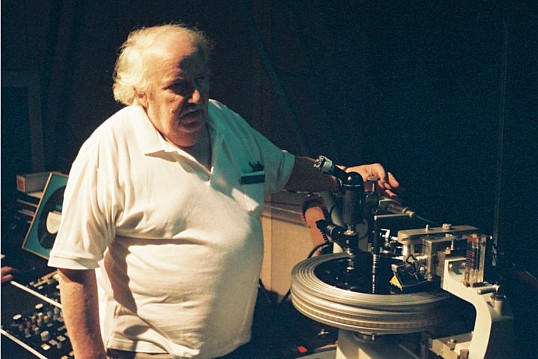
The band during a take. (Photo by Howard Sanner)
We were fortunate in the musical group that was engaged for the recording session. Keyboard player Rob Aries brought us a jazz/fusion quartet, which also featured Bill Harris on tenor sax, Dave Anderson on fender bass and Terry Silverlight on drums. They were all superb musicians, which made my job much easier than it could have been. Due to the half acoustic - half electric nature of the group, and the fact that we were recording in an exhibit room with indifferent acoustics and potential background noise problems, I decided on a conservative multi-microphone setup with the electronic instruments recorded through direct boxes. For a comprehensive explanation of the recording setup with floor plan, block diagram, etc., follow this link.
Thanks to the extensive planning and preparation beforehand, the recording session went smoothly. Historical Committee member David Baker gave a short spoken introduction to the audience. I then explained the recording setup and Al Grundy spoke about the particular technical issues relevant to recording directly to the disc cutting lathe from a live signal. He then cut the lead-in to the first master lacquer, I cued the band to start playing, and off we went.
In order to minimize groove spacing problems, the stress on the musicians, etc., we had decided to record only one tune per lacquer disc. This was, after all, only a demonstration of direct-to-disc recording technique; the creation of a commercial Lp issue was not our intent. After the first tune had been recorded, Al cued up the master lacquer and played it back through the Altec speakers. I had never heard playback from a freshly cut master lacquer before. The fidelity was remarkable; wide dynamic range, clean transients, all against a dead quiet background. The big theater speakers were able to match the level of the live band in the room without strain, which made the comparison all the more impressive.
(The MP3 file available for download from this page will give you some idea of what we heard. It is not a dub of the master lacquer, but is derived from the analog backup tape, recorded from the same mix as was sent to the cutting lathe.)

Al Grundy at the Neumann lathe.(Photo by Howard Sanner)
Al Grundy deserves a lot of credit for the success of the AES direct-to-disc session. There are a lot of things that can go wrong with a disc cutting lathe, and the direct-to-disc recordings of the 1970's experienced their share of technical problems. One of the more dramatic examples occurred during a recording by the Louie Bellson big band, when the thread of vinyl being cut from the disc managed to wrap itself around the cutting stylus and ignited, starting a fire in the cutting room! We experienced no such excitement at the Javits center. We recorded five tunes and Al cut five flawless discs. This is a good example of making the difficult look easy.
-Robert Auld, 1/28/02
 These days, the term "direct-to-disc" means recording to a computer hard drive. But in the 1970's, it referred to the audiophile technique of recording directly to a vinyl-disc cutting lathe, without the intervention of a tape recorder. It was a notoriously difficult way to record; the musicians and all concerned had to record a complete Lp side without any serious musical or technical mistakes. Otherwise, it was put another lacquer on the lathe and do it over. But the gain in sound quality was considered worth the trouble. (As typical commercial Lp releases were cut from fourth-generation analog tape copies, the improvement in sound offered by eliminating all those layers of tape and electronics was not illusory.)
These days, the term "direct-to-disc" means recording to a computer hard drive. But in the 1970's, it referred to the audiophile technique of recording directly to a vinyl-disc cutting lathe, without the intervention of a tape recorder. It was a notoriously difficult way to record; the musicians and all concerned had to record a complete Lp side without any serious musical or technical mistakes. Otherwise, it was put another lacquer on the lathe and do it over. But the gain in sound quality was considered worth the trouble. (As typical commercial Lp releases were cut from fourth-generation analog tape copies, the improvement in sound offered by eliminating all those layers of tape and electronics was not illusory.)

